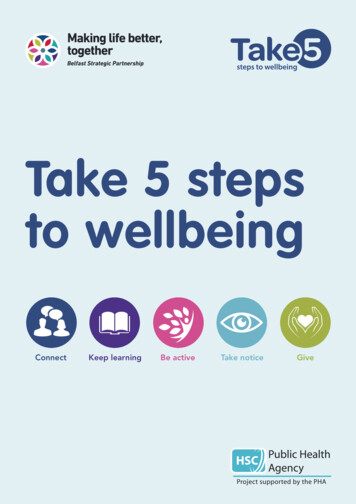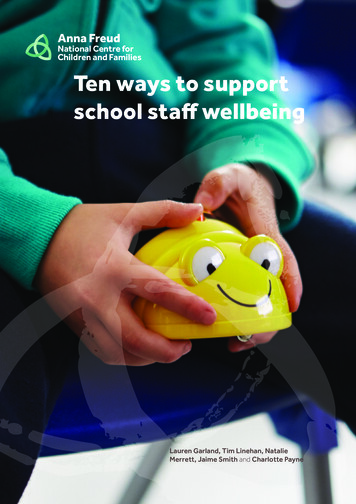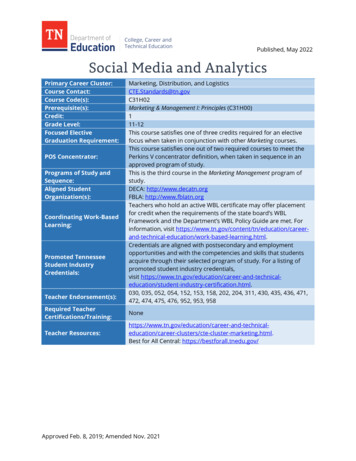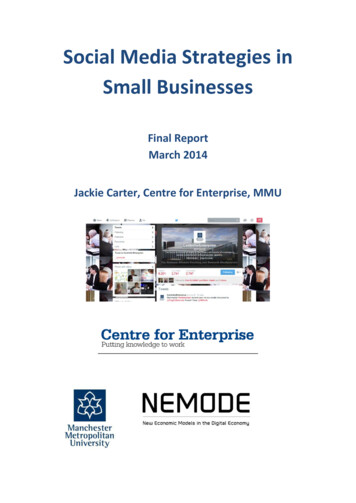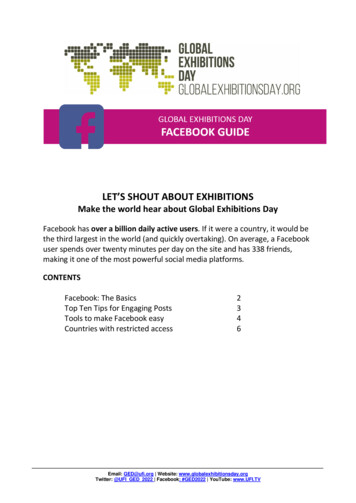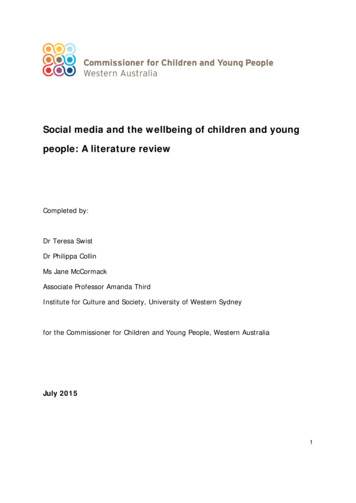
Transcription
Social media and the wellbeing of children and youngpeople: A literature reviewCompleted by:Dr Teresa SwistDr Philippa CollinMs Jane McCormackAssociate Professor Amanda ThirdInstitute for Culture and Society, University of Western Sydneyfor the Commissioner for Children and Young People, Western AustraliaJuly 20151
ContentsSocial media and the wellbeing of children and young people: A literature review . 1Acknowledgements . 3Executive Summary. 4Dimensions of social media use . 4Impacts of social media on wellbeing . 5Good practice and opportunities . 6Future needs . 7Introduction. 10Context . 11What is Social Media? How do Children and Young People Use it? . 12Technical dimension . 13Material dimension. 15Social dimension . 17Motivational dimension . 18Critical Literacies for a Digital Age . 21Role of Social Media for Children and Young People’s Wellbeing. 22Approaches to the Study of the Effects of Social Media. 23Summary of Recent Literature Investigating the Impacts of Social Media on theWellbeing of Children and Young People. 24Mental and physical health . 24Identity and belonging . 30Formal and informal learning . 35Play and recreation . 41Consumer practices . 452
Civic and political engagement . 52Risk and safety . 56Family and intergenerational relationships . 62Key Findings . 66Early uptake with practices and motivations changing, intensifying and diversifyingas children get older . 67Interrelated dimensions of children and young people's social media use . 67The impacts of social media use on the wellbeing of children and young people . 68Good practice and opportunities . 70Gaps and emerging research . 71Conclusion . 72References . 73AcknowledgementsThe authors are grateful to Ms Trish Heath (Commissioner for children and YoungPeople WA), Ms Anne Collier (NetFamilyNews.org) and Professor Ariadne Vromen(University of Sydney) for their advice on this review.Suggested citation: Swist, T., Collin, P., McCormack, J. & Third, A. (2015). Socialmedia and the wellbeing of children and young people: A literature review. Perth,WA: Prepared for the Commissioner for Children and Young People, WesternAustralia.3
Executive SummaryChildren and young people’s use of technology and social media is evolving at arapid pace, with implications for their wellbeing. To understand these changes thereneeds to be wider awareness of the types and use of social media, impacts onwellbeing – plus the range of good practice and opportunities available. Highlightingthese can help parents, caregivers, service providers, educators, policymakers andother adults better identify and respond to the challenges and opportunities ofchildren and young people’s social media use. To support effective policy, practiceand service innovation, this review examined literature published since 2010 onchildren and young people's use of social media and effects on their wellbeing.From the age of five nearly all Australian children regularly access the internet andby the time they become teenagers are avid users of social network services (SNS),online games and chat rooms, forums and instant messaging. As they increasinglygo online via a mobile device or phone their access has become more personalised,frequent, and possible in a wide range of public and private spaces.Social media is a set of web applications that enable production, aggregation,sharing and remixing of content from multiple sources by mass, networkedparticipants. They are giving rise to a rapidly evolving set of media practices and areincreasingly embedded in other media modalities – such as television, online gamesand search. Consequently, social media is becoming a common feature of childrenand young people's everyday lives. However, social media are diverse and theireffects on the wellbeing of children and young people are an emerging focus forresearch, policy and service delivery.Dimensions of social media useThis report identified four key dimensions that influence children and young people’ssocial media use:i)Technical dimension: hardware, software, connectivity and devices thatenable social media practices.ii)Material dimension: text, images and interactions that are produced andmade visible on digital platforms and devices.iii)Social dimension: with whom and how children and young people interactvia social media, which can promote and enhance interpersonalconnections at peer, family, local and global scales.4
iv)Motivational dimension: values and drivers of children and young people’ssocial media use expressed in the different ways they approach and utilisesocial media.Children and young people’s social contexts, along with their desires to maintainrelationships, express themselves to diverse audiences, and discover newinformation and ideas, profoundly shape their social media engagement.Impacts of social media on wellbeingThe review identified eight key domains of social media’s impact on children andyoung people: physical and mental health; identity and belonging; formal andinformal learning; play and recreation; consumer practices; civic and politicalengagement; risk and safety; and, family and intergenerational relationships. Amongother findings, the review has identified that positive and negative impacts arecontextual and that social media: Promote positive norms about health and wellbeing and enhances healthpromotion initiatives. The range of content and culture of social mediaprovides low level exposure to a range of risks. However, experiencing somelevel or risk is necessary to build resilience online and offline. The rapidlyincreasing volume of information available online also opens up newquestions about the sources and accuracy of information in the digital age.Foster identity formation, community-building and creativity. Across thesepositive developmental processes, children and young people can alsoexperience upsetting and potentially harmful content and practices which canhave serious effects on their wellbeing.Support the self-directed learning and aspirations of marginalised youngpeople and extend formal and informal knowledge networks and socialsupport for young people generally. However, poor integration of social mediain formal and informal learning networks can reinforce social exclusion.Provide new leisure, play and recreation spaces for children and youngpeople. Online and video games in particular provide opportunities forlearning, creativity, identity formation, socialisation, relaxation and stressrelief. There are significant opportunities for the exploration (anddevelopment) of games that enhance wellbeing. Additional research isnecessary to fully examine the range of concerns raised about online games.Can positively influence the consumption patterns of children and youngpeople by facilitating supportive networks and attitudes to financial wellbeingand empowering young people’s consumer and financial literacy. More5
research is required to understand the multiple influences from which harmfulconsumption practices can emerge. Create new spaces for young people’s civic and political engagement byopening up opportunities for diverse forms of participation, self-expression –as well as creatively addressing social issues. While only a small minority ofyoung people are considered to be at risk of radicalisation, social media canalso be used to circulate politically extremist messages which, alongside othercomplex factors, can potentially lead to harmful practices. Can amplify risks to physical and emotional safety but can also promoteproactive approaches to issues of risk and safety that empower children andyoung people, develop their resilience and support their wellbeing. Support family and intergenerational relationships that utilise different formsof expertise – including knowledge and skills of children and young people,peers, family and other adults – to promote safety, wellbeing and resilience.Also important to consider are the range of factors which influence childrenand young people’s social media use (such as where they are, what devicethey are using, what activity they are doing – and who they are with).Good practice and opportunitiesThis review finds that the benefits of social media for wellbeing can be maximised byvaluing the positive possibilities of children and young people’s social media use.That is, good practice in research, policy and service design should focus on themultiple dimensions (technical, material, social and motivational) that support andstrengthen children and young people’s social media use, such as: Fostering ‘digital age literacies’ among children and young people which spanmedia, internet and social-emotional literacies that consider not only the safeuse of social media, but the moral and ethical repercussions of their everydaypractices.Promoting peer and intergenerational capacities and support (online andoffline) so as to foster skills, promote shared understandings and maximisepositive opportunities for children and young people’s wellbeing.Involving children and young people in the design of social media platforms,mobile devices, policies and programs for wellbeing. In these processes it isimportant to consider cultural and linguistic norms, technology access andopportunities to participate.Encouraging industry involvement in developing strategies to promote thepositive impacts of social media on wellbeing and supporting strategies topromote the digital capacity and resilience of individuals and communities.6
Building formal, informal and shared learning networks enabled through socialmedia, cloud computing and mobile technology which connect diversepathways, knowledge and expertise.Further research which looks more specifically at the commercial imperatives andtechnical affordances of particular social media platforms, alongside the complexcircumstances of children and young people (spanning the geographical, social,cultural, political, emotional and psychological) is vital to ongoing policy, service andpractice innovation.Future needsWhile research on children and young people’s social media practices and wellbeingis burgeoning, there is relatively little research on the practices of children under theage of twelve. Internet access for children under the age of nine has significantlyincreased in recent years, yet there are major gaps in research and evidence abouttheir activities, capacities and the risks and benefits of their online practices. Moreresearch on this demographic – and marginalised population groups – is needed sothat findings from older groups are not simply extrapolated to younger children. Thisrequires building rigorous local, national, regional and international strategies for thestudy of children and young people's social media use. Such strategies must keeppace with technological change, address restrictions and challenges on researchingyounger age groups, and be meaningful to diverse contexts and communities.This review provides a high level snapshot of the evidence of children and youngpeople’s social media use and the effects on wellbeing. It shows the effects arebroadly positive, but are mediated by the social contexts, shared communication andfamilial conditions in which children and young people live and grow up. While theexisting literature provides for some insights on difference according to gender andsocio-economic advantage, there is a lack of close analysis on other aspects of livedexperience (such as geographical location and culturally and linguistically diversebackground). What is clear is that the benefits and risks of social media use map tobroader patterns of literacy levels, as well as socio-economic disadvantage.Intervening in this cycle has the potential to generate a steep change in thewellbeing of the children and young people who stand most to gain from thebenefits social media offer. Such efforts must not only be informed by research, butby the views and preferences of children and young people themselves.7
GLOSSARYAffordance: the relation between context, technology and a person’s actions.App/application: a software program which is downloadable on a mobile device, orcomputer (for example, web-based apps).Asynchronous: Online communication happening at different times, or notsimultaneously (opposite of ‘synchronous’ communication. See below). For example,wikis, blogs and forums.Avatar: an online character, or representation, of the user.Blog: an online site which has content posted by an individual, or organisation.Cloud computing: digital platforms and infrastructures operated by distantcomputing (‘in the cloud’).Critical literacies: the range of media, digital, social and emotional literacies requiredto negotiate and navigate the digital age competencies (Aspen Institute Task Forceon Learning and the Internet, 2014).Digital infrastructure: facilities and systems that support and connect digitalplatforms and wireless services.Digital trace: online content and interactions visible to users (such as the ‘like’button) and digital platform providers.Digital platform: online content, such as apps, social networking sites (Facebook),user-generated content (Youtube) and curated content (Pinterest).Digital resilience: the capacity to respond to, learn from and move on in a positiveway from negative online experiences.Digital storytelling: communicating and sharing stories using digital tools.Electronic play: play experiences enabled by digital social games (Przybylski 2014).Experiential learning: building knowledge through learning activities that promotereflection and experience.Homebase: a room that users can decorate on SNS (e.g. Habbo Hotel) (Grimes &Fields, 2012).Interoperability: the exchangeability of data between diverse platforms and devices.8
Like: An online expression of enjoyment, recommendation or support (for examplethe ‘like’ button on Facebook).Micro-blog: an online site that has postings of a smaller size than a regular blog (forexample, Twitter).Mobile device: devices which can be easily carried or moved around and havewireless access, for example: mobile phones, laptops and tablets.Participatory culture: new opportunities for sharing and creating enabled by socialmedia.Profile: an online identity created for a social networking site.Social graph: a visualisation of online social connections specific to an individual user(built from their interactions on social networking sites)Social networking site: a digital platform which enable people to create profiles tocommunicate and connect with others (for example, Facebook, Instagram andSnapchat).Synchronous: online communication happening simultaneously, or at the same time(opposite of ‘asynchronous’ communication). For example, Skype and instantmessaging.Tag: keyword related to a piece of online information (helps to organise and classifycontent and assist with searching).Tween: a young person aged between 9 and 12.Uploading: transferring existing online content to a digital platform.9
IntroductionThis literature review was undertaken for the Commissioner for Children and YoungPeople Western Australia to provide: an overview of the categories and types of social media and how children andyoung people are currently engaging with them;an overview of the impacts of social media use on the wellbeing of childrenand young people;examples of current good practice and opportunities for using social mediaand online environments to engage with and/or deliver services andinformation to children and young people.Globally, there is a wide-ranging and ever-increasing amount of research emergingabout the impacts of social media and technology on children and young people’swellbeing. Nearly five years ago, members of this team conducted a similar reviewexploring the benefits of social network services (Collin et al., 2011b). Social mediahas rapidly evolved, becoming an ever more ubiquitous feature of social, economic,political and cultural life. Limits of time and scope mean that this report canvassesonly certain aspects of the available literature in this area: more detailed reviews arewarranted.For the purposes of this review, ‘children and young people’ means those 18 yearsold and younger. ‘Social media and online environments’ refer to technologicaldevices and platforms including social network services (SNS) such as Facebook,Instagram and Snapchat as well as blogs, chat rooms, gaming, online health,education and other services, apps, clouds, and sharing sites. ‘Social media’ alsorefers to the practices and social relations that are formed through social media. Asper the Scope of Work, online gambling, sexting, cyberbullying and cybersafety werespecifically excluded from this review, recognising that these areas requiresignificant attention in their own right.This literature review audited peer-reviewed and credible grey literature from 2010onwards, with a focus on Australian and Western Australian research, plus significantinternational publications. Literature published before 2010 and outside of thespecified age-range has been included where it is of particular significance. Forunder-examined areas regarding children and young people’s use of social media(for example consumerism, radicalisation), newspaper articles were referenced.Influential research beyond that specified in the scope (such as focusing ontechnology or internet use generally) is included where the implications for childrenand young people are significant. Due to word and time limit constraints as well as10
the breadth of literature to be covered, this review does not list all details (e.g.samples, methodologies, limitations) of every study mentioned.While social media is increasingly integrated into online education, health,entertainment and other services, quantitative research tends to differentiatebetween use of the internet for particular activities (homework, playing games,search, use of mobile phone apps etc.) with SNS used as a proxy for social mediapractices more generally. As such, this review often refers to SNS use, whilehighlighting that social media is increasingly integrated into many other onlineenvironments and activities.ContextThe experience of childhood and youth is social, complex and quickly evolving –especially in an age of social media. Although digitally mediated mobile, personalisedand social communicative practices are now a common feature of everyday life,there is significant diversity and unevenness in quality of access, use and impacts inrelation to the lives of Australian children and young people. Digital practicesaccumulate, change and vary according to the individual capacities, history,preferences, social milieu, economic resources, age and interests of individuals(Ellison & boyd, 2013). Moreover, the immediacy of new, ‘global media’ requiresyouth culture research, policy and practice to be responsive and able to change(Buckingham & Kehily, 2014) – especially in relation to social media. There is atendency in much of the popular and scholarly debate to focus on the risks and fearsassociated with the rapid development of social media practices. Instead of asingular focus upon the concerns and discomforts of children’s technology use,Ruckenstein (2013) advocates adopting a socio-cultural perspective, which highlightshow digital life produces new forms of participation and consumption and child-adultrelations. Policy makers, parents, educators and scholars require new approaches tounderstand how social life is changing in the context of digital communication – onand offline. This requires moving beyond static views of children and young people’srisk and empowerment in the digital age towards a focus on how to support,negotiate and open up the positive aspects of social media so as to enhance‘pluralities’, ‘playfulness’, ‘possibilities’ and ‘participation’ (Craft, 2013). The digitalage is fundamentally a networked age where children and young people are exposedto life well beyond immediate peer, schooling and family groups through these newand dynamic online networks. As such, their experiences are individual, situationaland contextual (Collier, 2015).Children’s rights and capabilities provide a useful lens for examining themultidimensional impacts of young people’s media use according to diverse socio11
cultural contexts. Third and colleagues argue: “[a]s it becomes increasingly difficultto draw the line between offline and online, it is necessary for us to examine howthis changing environment impacts the wellbeing and development of children andtheir rights” (Third et al., 2014a: 6). This recognises the agency of children, theirwelfare needs and the power differentials that shape children’s rights (Nussbaum &Dixon, 2012). It focuses attention on what enables and/or constrains children andyoung people to participate in a networked society. Moreover, a strengths-basedapproach focused on building on existing child and youth cultures, skills andcapabilities is most likely to maximise the benefits and mitigate the potential risks ofsocial media (Collin et al., 2011b:11). ‘Critical literacies’ can be defined as the rangeof media, digital, social and emotional competencies that children and young peoplerequire to negotiate and navigate the digital age (Aspen Institute Task Force onLearning and the Internet, 2014). A focus on these is necessary in order to fosterthe resilience of children and young people and to address their particular needs,expand their opportunities for participation in the community and equip them withthe tools to critique, explore and change the digital world around them. In herinfluential book, ‘It’s complicated: the social lives of networked teens’, boyd (2014)argues that:Networked publics are here to stay. Rather than resistingtechnology or fearing what might happen if youth embrace socialmedia, adults should help youth develop the skills and perspectiveto productively navigate the complications brought about by livingin networked publics. Collaboratively, adults and youth can helpcreate a networked world that we all want to live in. (p.213)What is Social Media? How do Children and YoungPeople Use it?Social media can be defined as a set of web applications that (a) rely on theparticipation of mass groups of users rather than centrally controlled contentproviders, (b) aggregate and remix content from multiple sources, and (c) moreintensely network users and content together (O'Reilly, 2007; cited in Ahn, 2011).Social media can now be accessed via multiple platforms (eg Twitter and Youtube)and mobile devices (eg mobile phones, tablets and laptops). They are alsoincreasingly integrated with traditional media (eg. television, newspapers and radio)for re-broadcast and intermixing with ‘newer’ media. In this way, social media offersnew expectations, interactions and activities – such as user-generated content,remixing and dissemination (Bruns, 2008). This is associated with the rise of‘participatory culture’, which shapes children and young people’s expectations as12
active agents in media practices and the world around them (Jenkins et al., 2006).Social media can thus also be understood as a ‘cultural mindset’ towards the diverseproduction, use and purposes of digital communications (boyd, 2014). This diversitycan be broken down into technical, material, social and motivational dimensions.While these dimensions are interrelated, individually they illustrate specific enablersof, and constraints, on children and young people’s social media practices.Technical dimensionThe technical dimension refers to the hardware, software, connectivity and devicesthat enable social media practices. Almost all Australian children and young peoplehave regular access to the internet and by age fourteen around 50 per cent goonline using a mobile phone (Australian Communications and Media Authority,2013). From as young as five, children are using social media (including SNS) withuse significantly increasing as they get older (Green et al., 2011; AustralianCommunications and Media Authority, 2013; Holloway, 2014). The majority ofAustralian children and young people regularly engage in a variety of activities thathave social media components including gaming, SNS and instant messaging (Greenet al., 2011). In 2012 the Australian Communications and Media Authority conducteda major study of Australian children and young people’s social media practices, witha focus on SNS (Australian Communications and Media Authority, 2013). A surveywas completed by 1,511 Australians between the ages of eight and 17, with datapost-weighted to produce estimates for all young people in that age group. Thestudy found that the majority of eight to 17 year olds in Australia had used SNS (‘78per cent of eight to nine year olds; 92 per cent of 10 to 11s; 88 per cent of 12 to13s; 97 per cent of 14 to 15s and 99 per cent of 16 to 17s have used social networkservices at some stage’: 38), and that the frequency of use increases with age (‘36percent of 12 to 13 year olds reported daily SNS use on a computer, with this figureincreasing to 71 per cent for 16 to 17 year olds’: 8).Global trends in internet access and social media practices (including the growth inuse of smartphones and other internet-enabled devices) indicate that children’s useis likely to have increased since the Australian Communications and Media Authoritystudy. Holloway finds that “[c]hildren’s internet use is rapidly changing. Tweens' (9to 12 years) usage patterns now resemble those of teenagers five to six years ago,and younger children’s (5 to 8 years) usage is approaching that of tweens”(Holloway, 2014: 2). Moreover, Australian children and young people’s use is similarto - or higher - than comparable countries – particularly in terms of mobile internetaccess (Green et al., 2011). While the popularity of specific platforms changes overtime, Australian children and young people’s use is comparable with that of children13
in other English speaking countries such as the USA. For example, 71 per cent of 13to 17 year olds in the USA and 77 per cent of 12 to 17 year olds in Australiaregularly use Facebook (Lenhart & Pew Research Center, 2015; AustralianCommunications and Media Authority, 2013).Technical dimension of children and young people’s social media practiceAffordances collaborative projects (Wikipedia)blogs and micro-blogs (Twitter)content communities (YouTube)social networking sites (Facebook)virtual game worlds (World of Warcraft)virtual social worlds (Second Life)(Kaplan & Haenlein, 2010)Relevant statisticsAustraliaAustralian Communications and Media Authority (2013) reported that, as at 2012: 43 per cent of 10 to 11 year olds used the internet on a mobile device and 54per cent of 16 to 17 year olds went online via their mobile phone. Access viamobile devices (including tablets, handheld media players, gamedevices/consoles) increases with age.78 per cent of 8 to 9 year olds and 92 per cent of Australian 10 to 11 yearolds had used SNS. The most popular platforms were YouTube, MoshiMonsters and Club Penguin. Despite minimum age requirements (13 years),61 per cent of 8 to 12 year olds used Youtube and 32 per cent usedFacebook.88 per cent of 12 to 13 year olds and 97 per cent of 14 to 15 year olds useSNS. 92 per cent of 16 to 17 year olds use SNS, with 71 per cent using atleast daily.Among 12 to 17 year olds Facebook was the most popular platform, followedby YouTube, Skype and Windows Live Messenger. Tumblr and Twitterf
Avatar: an online character, or representation, of the user. Blog: an online site which has content posted by an individual, or organisation. Cloud computing: digital platforms and infrastructures operated by distant computing ('in the cloud'). Critical literacies: the range of media, digital, social and emotional literacies required




